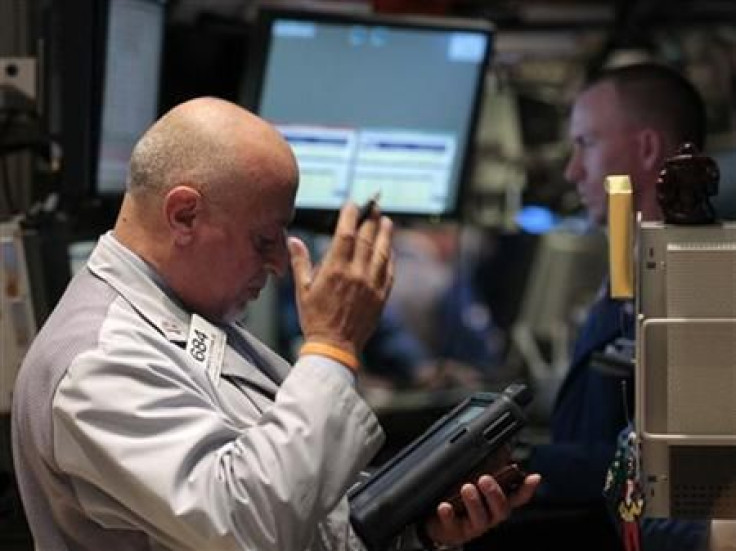U.S. Stocks - Is the Dow’s Pull-Back a Buying Opportunity?
ANALYSIS

Talk about an unnerving start to the week for U.S. investors: first the Jon Corzine-led MF Global files for bankruptcy, now Greece Leader George Papandreou upsets the stabilization plan apple cart by calling for a referendum -- triggering jitters in institutional investor circles, due to the amount European bank exposure to Greek debt.
With the above as a backdrop, the important question for the typical investor is, 'Where's the Dow likely to head in the next six months?'
The market's bulls -- those who say the Dow is headed higher -- argue that despite the fact that the U.S. economy grew at a sub-optimal 2.5 percent rate in the third quarter, private sector lay-offs most likely have peaked, auto sales are still trending up, the manufacturing sector is still expanding, exports remain adequate and there are signs that corporations may be willing to deploy capital for new projects.
Conversely, the market's bears -- those who say the Dow will decline -- argue the substantially smaller U.S. workforce, stagnant income in many job classifications, an economy that's short - - at minimum -- about 14 million full-time jobs, the ongoing partisan feud in Washington between Democrats and Republicans, and now concern about Greece's possible rejection of the Eurozone's invention, and contagion in Italy. create more than enough storm clouds for the U.S. economy.
Let's do a condensed, cross-methodology analysis to see if we can arrive at an informed investment decision/conclusion regarding where the Dow is headed, near-term.
Technical Indicators: Netural/Mixed. The Dow is above the key, 50-day (11,357) moving average, but it's below the 200-day (11,973) moving average. The Dow also has technical support at/near 11,400.
Fundamental Indicators: Neutral/Mixed. The third quarter earnings season turned out to be slightly better than expected. However, the U.S. economy, as measured by GDP, is still growing at an inadequate rate, and the U.S. Federal Reserve's latest Beige Book regional economic summary indicated that the regional economic recovery continued at a modest pace, with some districts noting mixed or weak activity. Initial jobless claims also remain above the psychologically significant 400,000 level. Further, the economy has not demonstrated that it can create the minimum 150,000 to 200,000 new jobs per month, just to lower the nation's high unemployment rate (presently 9.1%).
Monetary Policy: Slightly Bullish. Despite three phases of quantitative easing (QE, QE2, and Operation Twist) by the U.S. Federal Reserve, inflation remains low, at the core level (which excludes food and energy prices). That relatively low inflation, combined with the output gap, means the Fed will at least continue to reinvest the proceeds from its quantitative easing policy to help stimulate the economy, through at least the start of the first quarter of 2012, and perhaps for longer. On the other hand, the Fed's Operation Twist subbing the purchase of $400 billion in long-term debt in place of $400 billion in short-term debt was deemed a status-quo move by institutional investors, in terms of credit availability, when the market wanted an expansion,
Fiscal Policy: Bearish. The U.S. Congress, led by Tea Party-pressured Republican majority in the U.S. House, won the debt deal debate, and as a result Congress implemented austerity measures too soon. Deficit reduction and weeding-out needless programs are laudable goals, but reducing the deficit too fast -- especially if spending cuts affect the social safety net -- reduces demand, and could very well increase social problems -- leading to even higher social costs down the road. Also, a bipartisan super committee is trying to cut at least another $1.2 trillion from the deficit; long-term, the markets will cheer it, but short-term, it is bearish.
Credit Markets: Recovering, but still strained, with still too many small/medium-sized businesses arguing they're not getting the level of credit they need to expand operations. Home mortgage qualifications terms remain very high. Home mortgage rates, however, are at/near 50-year lows, averaging about 4.2 percent for home buyers with excellent credit.
Further, Europe's sovereign debt situation remains clouded, and there could be more financial market ripples. Greece must approve the Eurozone intervention package. If it doesn't, institutional investors will interpret it as a move by Greece to either break away from the euro or otherwise rejection the Eurozone intervention package.
Conclusion: The view from here argues that the outlook for U.S. stocks and the U.S. stock market is Slightly Bearish for at least the next three months -- through early January. The bias is to hold off considering new stocks or adding to current stock positions, at least until mid/late December.
Given the above technical and fundamental indicators, pull-backs in the Dow and S&P 500 are likely to occur. Underscoring, the current stock market is highly selective, and the bias is toward only deploying capital in those clear-winner stocks.
In sum, the market needs ample, bullish U.S. economic data to support the Dow, and right now the pool of positives is not large enough.
© Copyright IBTimes 2024. All rights reserved.











